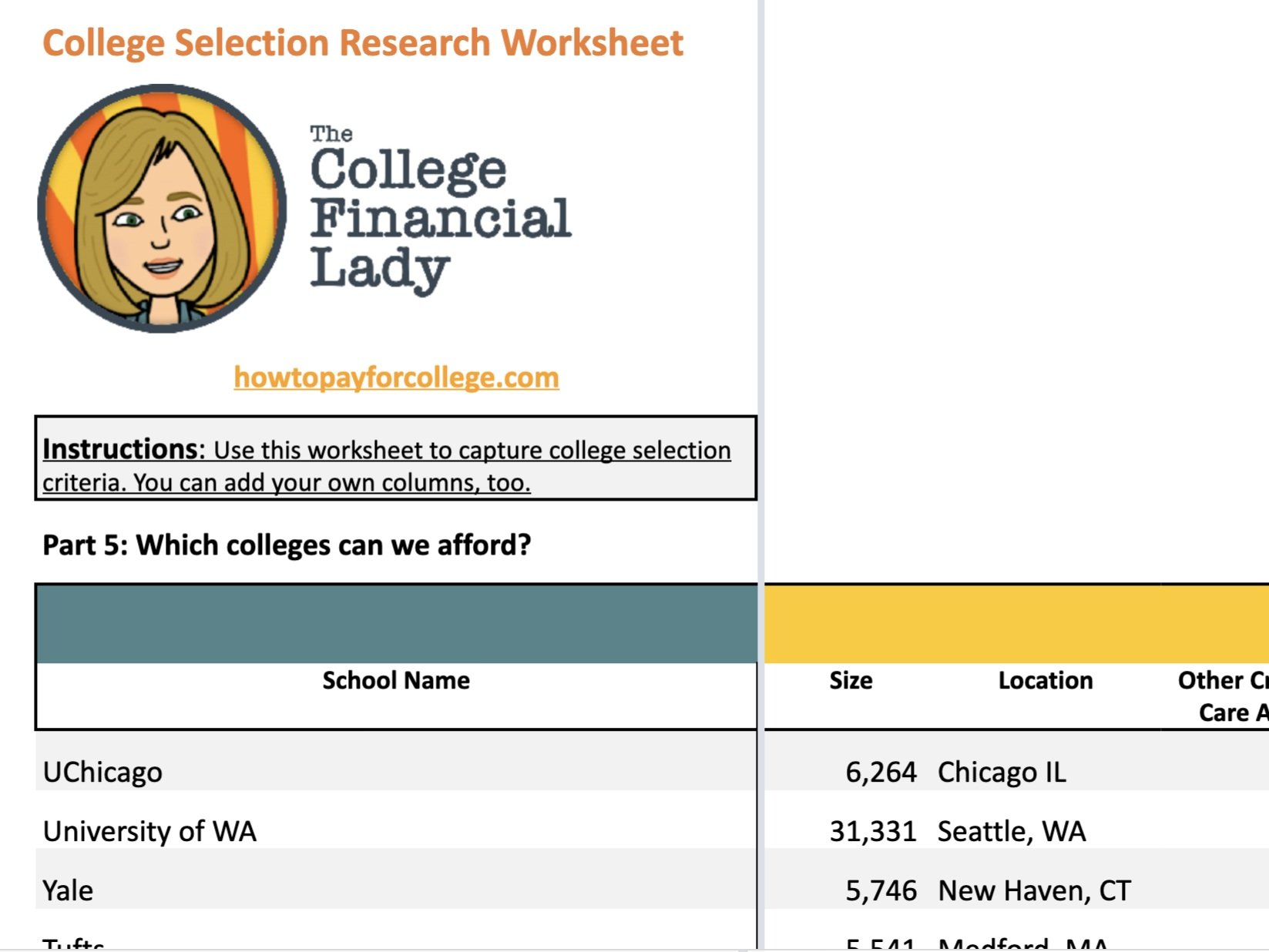
College Research Worksheet
Use the free worksheet from my College Financial Plan Masterclass that will help you centralize all the key aspects of the colleges your student is considering.
Develop an objective college research framework
Now that you’ve got a solid foundation from the previous sections (the Choosing a College Getting Started and Net Price Calculators Matter sections) of this website, you and your student are ready to jumpstarting your college research process.
I think every family should start by researching their in-state colleges. In the worksheet for the last section, I asked you to look up merit awards offered by your in-state schools to see what your student might be eligible for. This is a good starting point because it gives you a baseline cost for four years of college. You should consider some other items with your in-state school, which will vary by student. For example, is there a dual enrollment program where students can be jointly enrolled at a local community college and the four-year college so that they can take lower-cost classes at the community college? Is there an honors college? What about student engagement through things like academic residential communities, intramural sports and other activities that can help students find a home on a big campus?
Creating your college list
I’m sharing my College Research Worksheet (scroll down to Researching Colleges) from my College Financial Plan Masterclass to help you with this process and give you a sample of the type of content included in comprehensive resource. The worksheet is customizable and contains a ton of fields that you can fill out for each school you’re interested in. I break them down into a few categories:
General information including:
Size, location (urban/suburban/rural or other breakdown that matters to you), other demographics of interest to you
Is the degree/major you’re interested in offered?
Housing information (how long do students live on campus vs off?)
Quarters or semesters?
Social considerations that matter to you: athletics, theater, Greek life, academic residential communities, interest groups, …
Application and admissions information including:
Application deadline
Application fee and fee waiver eligibility/process
Letters of Recommendation
Supplemental essays (have a column for the essay prompts)
Top quartile GPA (from Collegedata Admissions tab)
Top quartile ACT/SAT scores (from Collegedata or College Navigator Admissions tab)
Test optional or test blind
Financial information including:
List price (Cost of Attendance) (from the school’s website)
Expected net price (from net price calculator)
Is the CSS Profile required?
Transfer credit policy (will you get credit for your AP/IB/dual credit classes)
Scholarship information including:
Is merit aid offered?
Scholarships available that are not reflected in the net price calculator
Application process and deadline for scholarships
Are SAT/ACT scores considered for any scholarships?
Why I would choose this school
Online resources to help answer the above
You’re probably thinking, that’s a ton of information-- how can I possibly find it all out? There are a few sources I like: the school websites themselves, and my two favorite aggregator sites, CollegeData and College Navigator. And perhaps the most important site of all, Google. That’s because a lot of the info you want isn’t going to be upfront on the school’s website and if it isn’t, google will usually get you there quicker than trying to navigate a college website. I’m going to focus on the money aspects of the spreadsheet because different students and families might place different values on different qualitative aspects.
Big Future is the College Board's website and offers a similar suite of data on admissions, financial aid and scholarships. One tool Big Future offers, under the Academics & GPA tab, is "How do I stack up?" This allows the student to input their GPA, coursework information, test scores and class rank and see where they fall relative to the student body. In addition, the Paying tab shows payment plans offered. Big Future also shows other schools that people looking at a specific school also viewed.
One additional resource you should be aware of is The College Scorecard, created by the U.S. Department of Education. The site is different than the above as it focuses on outcomes. It has the most reliable data on college costs, graduation, and post-college earnings. In addition, it shows average federal student loan debt and monthly loan payments, for both student loans and parent PLUS loans.
Cost vs ROI reality check
The College Scorecard can help your student get a financially grounded perspective on costs and the likely starting salary for different majors. For example, if your student has their heart set on studying philosophy in NYC at New York University but your budget can support an in-state college the site can help serve as a reality check and stating point for a conversation about affordability and the significant downsides of borrowing too much— median starting salary for philosophy graduates with a B.A. is $24,912 and NYU’s published list price of $80,878 + Travel. This is not intended to criticize pursuing a degree in philosophy, but it is important to consider how you’re going to pay for college without compromising your retirement and/or your student’s future financial situation.
Next section: The FAFSA & CSS Profile
Learn about the FAFSA & CSS Profile and why they’re important to your student’s college experience.
Free Worksheet
Start building your college list now. Enter your email to get access to this proven tool that has helped people just like you.
The best way to centralize your college research
This Excel worksheet provides you with all the essential data points your student should be collecting as you research colleges. It will help you and your student holistically evaluate and choose a great college.


